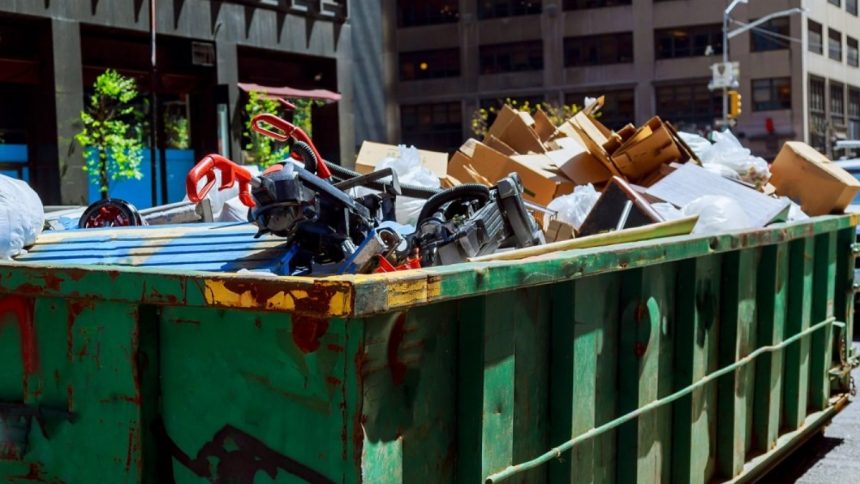Taking on large projects like home renovations, business cleanouts, or community events can quickly become overwhelming. Roll-off dumpster rentals offer a streamlined solution that simplifies waste management and boosts project efficiency. By providing centralized waste disposal, they help keep your workspace organized, allowing for a smoother and more manageable process.
Imagine the convenience of having a single, secure location for all your waste. No more multiple trips to the landfill or cluttered workspaces. This means less time and effort spent on cleanup, letting you focus more on completing your project efficiently.
Key Takeaways
- Dumpster rentals enhance efficiency for large projects.
- They provide a central, organized location for waste disposal.
- Safer work environments are established by containing debris properly.
Understanding Dumpster Rental Basics
Dumpster rentals can simplify large-scale projects such as home renovations, business cleanouts, and community events. This section will explore key considerations for choosing the right dumpster size, understanding local regulations, and determining rental periods.
Choosing the Right Dumpster Size
Selecting an appropriate dumpster size is crucial. Dumpsters come in various sizes like 10, 20, 30, and 40 cubic yards. For small projects, a 10-yard dumpster, typically 12 feet long, 8 feet wide, and 3.5 feet high, may suffice.
Larger projects might require 30 or even 40-yard dumpsters. These larger options accommodate significant amounts of waste, making them ideal for major construction work or extensive renovations. Always factor in the volume of debris generated to ensure you select the right size.
Navigating Local Regulations and Compliance
Compliance with local regulations is vital when renting dumpsters. Many municipalities have specific rules about placement, permits, and accepted waste types. You should consult your local government or sanitation department to understand these regulations.
Some areas may require permits for placing dumpsters on public streets. Ensure that you comply with these rules to avoid fines or project delays. Being proactive in this regard can save considerable time and expense.
Evaluating Rental Periods and Scheduling
The rental period depends on the project’s length. Short-term projects might only need a dumpster for a few days, while long-term renovations could require rentals lasting several weeks. Determine the ideal rental duration based on your project timeline.
Scheduling is also important. Plan to have the dumpster delivered a day before the project starts and removed promptly once completed. This planning helps prevent logistical issues and ensures efficient waste management throughout your project.
Optimizing Waste Management for Projects
Efficient waste management is crucial for large-scale projects such as home renovations, business cleanouts, or community events. Proper handling of construction debris, effective loading techniques, and recycling efforts can all contribute to a more streamlined project.
Efficient Removal of Construction Debris
Dumpsters play a vital role in managing construction debris. Renting a dumpster allows you to keep the job site clean and organized. This minimizes hazards and enhances productivity. For instance, during a home renovation, quick and consistent removal of debris.
Timely removal of debris also means fewer disruptions in project timelines. Frequent pickups and drop-offs can ensure that the project keeps moving. By selecting the right size dumpster, you can easily manage waste levels without overflowing issues. Generally, a 20-yard dumpster works well for medium-scale renovations, while large projects may require a 40-yard container.
Implementing Effective Loading Techniques
Proper loading techniques can optimize your waste management efforts. Distributing the weight evenly in the dumpster helps maximize space and prevent overloading one side. Start by placing flat items like plywood and drywall at the bottom before adding bulkier debris. Compressing waste through strategic placement allows you to fit more material into the dumpster.
It’s also important to follow safety guidelines while loading. Over-the-top piling can lead to accidents, and local regulations may require waste to stay within the container’s walls. Being mindful of these practices not only ensures compliance but also contributes to efficient project management.
Striving for Sustainability through Recycling and Reuse
Recycling and reusing materials can significantly lower the amount of waste headed for landfills. Implementing recycling protocols on-site can help separate reusable materials like metal, glass, and certain plastics from general waste. This not only benefits the environment but also reduces dumpster rental costs.
Consider setting aside areas for materials that can be donated or reused. For example, salvaged wood from a construction site could be repurposed for another project. Encouraging the team to sort materials properly can lead to a more sustainable and efficient waste management strategy, aligning with broader environmental goals.
Lynn Martelli is an editor at Readability. She received her MFA in Creative Writing from Antioch University and has worked as an editor for over 10 years. Lynn has edited a wide variety of books, including fiction, non-fiction, memoirs, and more. In her free time, Lynn enjoys reading, writing, and spending time with her family and friends.















